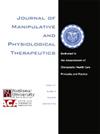Influence of Changing Hip Position on Electromyographic Activities of Selected Trunk Muscles During Bridging Exercises in Healthy Subjects: A Cross-Sectional Study
IF 1.4
4区 医学
Q4 HEALTH CARE SCIENCES & SERVICES
Journal of Manipulative and Physiological Therapeutics
Pub Date : 2024-01-01
DOI:10.1016/j.jmpt.2024.08.010
引用次数: 0
Abstract
Objective
The purpose of this study was to investigate how rectus abdominis, external oblique (EO), internal oblique (IO), erector spinae, multifidus (MF), and gluteus maximus (GMax) muscle activities change with different hip positions during back and side bridging exercises.
Methods
Thirty-six healthy individuals participated in this cross-sectional study and performed 6 exercises including back bridging (BB) in neutral hip position, BB with internal rotation, BB with external rotation (BB + ER), side bridging with hips in neutral (SB), side bridging with hips in flexion (SB + HF), and side bridging with hips in extension (SB + HE). Muscle activity was observed using surface electromyography, normalized using maximum voluntary isometric contraction. Repeated-measures 1-way analysis of variance compared muscle readings for each position.
Results
Back bridging with internal rotation showed significant differences in EO (P = .01) and IO (P < .001) compared with other BB positions. Multifidus and GMax differed significantly in BB + ER (P = .04). Side bridging exhibited significant differences in EO (P = .02; P < .001) and IO (P < .001) compared with the other 2 SB positions, with peak in SB + HF. Erector spinae, MF, and GMax also differed significantly (P < .001, P = .02, P < .001, respectively) with peak in SB + HE.
Conclusion
The findings revealed that EO and IO muscles were most active during BB with internal rotation, whereas the MF and GMax muscles were most active during BB + ER. In terms of SB, the EO and IO muscles were most active with either SB + HF or SB + HE, whereas the erector spinae, MF, and GMax muscles were most active with SB + HE.
健康受试者在桥式运动中改变髋关节位置对部分躯干肌肉肌电活动的影响:一项横断面研究
研究目的本研究旨在探讨腹直肌、腹外斜肌(EO)、腹内斜肌(IO)、竖脊肌、多裂肌(MF)和臀大肌(GMax)的肌肉活动在背桥和侧桥练习中随不同髋关节位置的变化而变化的情况:方法:36 名健康人参加了这项横断面研究,并进行了 6 项练习,包括髋关节中立位的背部桥接(BB)、内旋桥接、外旋桥接(BB + ER)、髋关节中立位的侧面桥接(SB)、髋关节屈曲位的侧面桥接(SB + HF)和髋关节伸展位的侧面桥接(SB + HE)。使用表面肌电图观察肌肉活动,并使用最大自主等长收缩进行归一化。重复测量单因素方差分析比较了每种姿势的肌肉读数:与其他 BB 体位相比,内旋背桥在 EO(P = .01)和 IO(P < .001)方面存在显著差异。多裂肌和 GMax 在 BB + ER 中差异显著(P = .04)。与其他 2 个 SB 体位相比,侧桥在 EO(P = .02;P < .001)和 IO(P < .001)方面存在明显差异,在 SB + HF 中达到峰值。脊肌、MF 和 GMax 也有显著差异(分别为 P < .001、P = .02 和 P < .001),在 SB + HE 时达到峰值:结论:研究结果表明,在内旋位 BB 时,EO 和 IO 肌肉最为活跃,而在内旋位 BB + ER 时,MF 和 GMax 肌肉最为活跃。就 SB 而言,EO 和 IO 肌肉在 SB + HF 或 SB + HE 时最为活跃,而竖脊肌、MF 和 GMax 肌肉在 SB + HE 时最为活跃。
本文章由计算机程序翻译,如有差异,请以英文原文为准。
求助全文
约1分钟内获得全文
求助全文
来源期刊
CiteScore
3.00
自引率
7.70%
发文量
63
审稿时长
29 weeks
期刊介绍:
The Journal of Manipulative and Physiological Therapeutics (JMPT) is an international and interdisciplinary journal dedicated to the advancement of conservative health care principles and practices. The JMPT is the premier biomedical publication in the chiropractic profession and publishes peer reviewed, research articles and the Journal''s editorial board includes leading researchers from around the world.
The Journal publishes original primary research and review articles of the highest quality in relevant topic areas. The JMPT addresses practitioners and researchers needs by adding to their clinical and basic science knowledge and by informing them about relevant issues that influence health care practices.

 求助内容:
求助内容: 应助结果提醒方式:
应助结果提醒方式:


